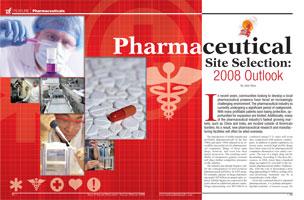
 In recent years, communities looking to develop a local pharmaceutical presence have faced an increasingly challenging environment. The pharmaceutical industry is currently undergoing a significant period of realignment. With many profitable patents soon losing protection, opportunities for expansion are limited. Additionally, many of the pharmaceutical industry’s fastest growing markets, such as China and India, are located outside of American borders. As a result, new pharmaceutical research and manufacturing facilities will often be sited overseas.
In recent years, communities looking to develop a local pharmaceutical presence have faced an increasingly challenging environment. The pharmaceutical industry is currently undergoing a significant period of realignment. With many profitable patents soon losing protection, opportunities for expansion are limited. Additionally, many of the pharmaceutical industry’s fastest growing markets, such as China and India, are located outside of American borders. As a result, new pharmaceutical research and manufacturing facilities will often be sited overseas.
The introduction of wildly popular and profitable pharmaceuticals in the late 1980s and early 1990s ushered in an incredibly successful era for pharmaceutical companies. Many of these same drugs, however, will soon lose their patent protection. The resulting availability of inexpensive generic versions will place further competitive pressures on the industry.
The industry has already begun to suffer the consequences of non-exclusive pharmaceutical portfolios. In 2005 alone, for example, patents on drugs representing nearly$25 billion in annual sales expired. Similar figures are expected in the years ahead as additional patents expire. Drugs representing over $60 billion in combined annual U.S. sales will soon face competition with generic counterparts. In addition to patent expiration, in recent years, several high profile drugs have been removed by pharmaceutical companies themselves over safety concerns. The loss of a single drug can be devastating. According to Decision Resources, in 2006, fewer than a hundred drugs accounted for over half of the domestic pharmaceutical market. Additionally, with the cost of developing a new drug approaching $1 billion, writing off a once-promising treatment can be a tremendously costly affair.
Given the continued threat to patented pharmaceuticals, it is perhaps unsurprising that economic growth in the U.S. and other mature markets is modest, at 5.7 percent annually. Meanwhile, sales from abroad are exploding. In countries such as India and China, dramatic increases in wealth have created lucrative markets for pharmaceuticals. In 2006 alone, sales in China grew 80 percent over the previous year. With promising foreign investment opportunities, global drug companies are finding financial success outside of traditional markets in the U.S. and Europe.
Faced with the economic and demographic realities of the market, many pharmaceutical companies have undertaken highly publicized downsizing efforts. In August, the New York Times reported that Johnson & Johnson would eliminate nearly 5,000 jobs worldwide. At least 600 of the job cuts were expected in America. Earlier in the year, Pfizer announced that it would be shedding 10,000 jobs. This was nine months before the company announced that profits had fallen 77 percent.
Local announcements of layoffs are clearly reflected in national employment figures of the industry. After declining for three straight years, employment in the pharmaceutical industry has recently rebounded. Still, total employment remains below 2002levels.
Despite the many challenges facing the industry, pharmaceutical companies remain popular targets for communities throughout the country. Simply put, the pharmaceutical industry creates well-paying jobs that also produce significant indirect benefits. Over the past five years, an era of decreased profitability for the industry, the average salary of a pharmaceutical worker jumped from $73,000 to $90,000. During this same period, the average salary of a worker for a private firm in America rose from $36,000 to $42,000. The increased earnings of pharmaceutical workers are reflected in the multiplier effect of the industry. According to the Milken Institute, an economic think tank in California, every job in the pharmaceutical industry produces an additional 5.7 jobs in other industries. In light of these numbers, it is unsurprising that site selectors working on behalf of pharmaceutical clients are aggressively pursued by communities throughout the country.
Recognizing the potential benefits a pharmaceutical company can bring to a region, more than 40 states have developed specifically targeted incentive and investment packages designed to attract the industry. Yet while there have been many local success stories, few states, without a significant historical pharmaceutical presence, have managed to break from the herd.
In 2002, just 11 states enjoyed a concentration of pharmaceutical employment that exceeded the national average. Although the industry experienced tremendous growth over the preceding decade, employment remained overwhelmingly concentrated in a few choice locales.
Five years later, the scene remains strikingly similar. Employment is the most heavily concentrated in the Northeast and Great Lakes regions. North Carolina, Utah and California remain relative islands of strong pharmaceutical presence.
Since 2002, only Rhode Island and Maryland have made the jump from states with below average employment in the pharmaceutical employment to join states with a significant concentration in pharmaceutical employment. These two regions greatly benefited from their proximity to existing pharmaceutical hotbeds and increased federal investment in pharmaceutical research and testing. During this same period, Michigan was the only state to drop from a concentrated pharmaceutical region to an area with a concentration below the national average.
Site Selection Criteria
The pharmaceutical industry remains largely wedded to a few privileged places. Why do pharmaceutical executives, when making decisions on facility expansion or relocation, consistently return to the same areas? And what characteristics have allowed communities outside of these select regions to successfully recruit pharmaceutical companies?
Workforce Availability & Research Resources
Workforce availability is often the most important locational decision factor facing pharmaceuticals executives. If many regions are quick to pursue pharmaceutical companies because of the industry’s high wages, they often overlook the factors that create high wages. Pharmaceutical workers are well compensated because such positions require extremely advanced levels of education that are often in short supply within America. This is particularly true of pharmaceutical research and development, which remains one of the strongest areas of pharmaceutical investment. Importantly, slowing sales of leading drugs have not negatively impacted spending on research and development.
The availability of an adequate workforce base is often determined by the presence of a well-funded academic research institution. University research arms are crucial to the pharmaceutical industry, as they remain largely publicly funded while managing to train tomorrow’s advanced workforce. The presence of research universities that can produce a sustainable pipeline of future workers is crucial to large pharmaceutical firms making long-term investment decisions. In addition to providing workers for the industry, research universities often produce initial scientific breakthroughs that are ultimately commercialized by pharmaceutical companies.
Physical Site Requirements
Although pharmaceutical executives may make investments based on long-term strategies, time is of the essence once a decision to relocate or expand has been made. Communities that successfully retain and recruit pharmaceutical companies are able to meet the physical site requirements for a proposed facility in a minimal amount of time.
Ideally, pharmaceutical firms want an immediately available site for their proposed operations. Specific requirements will ultimately vary according to the function of the proposed facility. Manufacturing facilities, for example, will likely require very specific minimum requirements in such areas as truck loading docks, transportation access, electricity costs, and wastewater treatment capacity. Research facilities, on the other hand, will place a greater emphasis on proximity to other research institutions such as universities and hospitals.
Lacking an immediately available site, a pharmaceutical executive may still consider a community due to the presence of other important criteria, such as workforce availability. Under such a scenario, however, it is crucial that the community provide an expedited and predictable process of permitting and construction for the proposed facility. Moving quickly through the process not only allows the pharmaceutical executive to initiate operations within a necessary timeframe but also demonstrates the community’s commitment towards forming a truly cooperative partnership with the company.
Incentives
While incentives do not typically drive the pharmaceutical site selection during the initial stages, they often become a paramount concern during final negotiations. Pharmaceutical executives are well aware that their relocation or expansion plans will ultimately provide communities with well-paying jobs and significant capital investments. Given the historic stature of the pharmaceutical industry, company officials often have a sophisticated understanding of the site selection process. Unlike many fledgling biotechnology firms, pharmaceutical executives are well-versed in strategic discussions with communities. While a community may aggressively market broad incentive packages designed to lure the industry, pharmaceutical executives should focus on those specific programs that best fit the firm’s construction and operational costs.
Finally, incentives are not only important to a pharmaceutical company’s bottom line, but they validate the community’s commitment to the company. Individual pharmaceutical expansion plans are often predicated on public improvements, tax exemptions on capital investments and workforce rebates. Infrastructure deficiencies of a specific site, such as limited wastewater capacity or restricted highway access, must be addressed by the community. Additionally, companies anticipating hundreds of millions of dollars in capital expenditures will expect favorable terms for their investment. A 5 percent exemption on capital expenditures, for example, may save a pharmaceutical company tens of millions of dollars in operational costs. Finally, with expansion plans typically producing additional well-paying jobs in the community, workforce rebates for new hires can further decrease operational expenses. As pharmaceutical companies remain heavily concentrated in extremely costly areas of the country, these savings can prove integral in an executive’s decision to remain in an expensive, established community rather than consider moving to a lower cost region.
Conclusion
The traditional pharmaceutical industry will continue to face significant challenges for the foreseeable future. Modest sales growth combined with shrinking patent portfolios will limit the ability of pharmaceutical companies to begin new operations in virgin environments. Instead, site selection will be primarily fueled by expansion considerations as companies with existing investments will look for ways to gain greater efficiencies from sites that are currently operational. As a result, states that already dominate the pharmaceutical industry will continue to enjoy their historical advantages.
Despite the relative entrenchment of the pharmaceutical companies, some newcomer regions have managed to develop successful industries. Most communities have done so either through a focused strategy aimed at fostering a specific pharmaceutical niche sector or by marketing the region as a less expensive alternative to pharmaceutical concerns in nearby areas. Officials in Missouri, for example, have established the state as a welcoming home for biotechnology firms by bringing together world class research facilities and a rich agriculture history. South Carolina, on the other hand, has made significant advances in establishing a local pharmaceutical industry over the past five years by marketing itself as a cheaper alternative to North Carolina, a proven place for pharmaceutical investment.
Regardless of the specific strategy, the pharmaceutical industry will be pursued as a potential engine of economic growth. With its high-paying employment opportunities and significant multiplier effects, this industry remains among the most economically beneficial industries for local economies.

